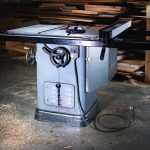We may receive a commission when you use our affiliate links. However, this does not impact our recommendations.
Tool: 1221 VS Lathe
Manufacturer: Jet
MSRP: $849.99
A mid-size lathe is a good compromise between a mini lathe and a full size lathe. You get greater capacity and versatility than a mini-lathe, and a smaller footprint with a degree of portability, compared to a full size lathe. The full-featured Jet 1221 VS is a welcome addition to the category.
The 1221 is heavy and solid; the bed, headstock and tailstock are all cast iron. It weighs in at just over 120 lbs., and the stand adds another 73 lbs. Mass is a big deal for turning, as it increases stability and cuts down on vibration. Also, the 1221 has three speed ranges – 60-900 rpm, 110-1800 rpm, and 220-3600 rpm – to suit whatever turning task you have. A ratcheting belt system makes it easy to change between speed ranges, delivering more torque at the slower speeds.
Within each range, the speed is infinitely adjustable; use the knob to dial in just the right speed for the job. A digital readout eliminates guessing the lathe’s rpm.
The 1221 has a 21-1/2″ working distance between centers, and a 12-1/2″ swing. You can also purchase a 22″ bed extension as well as an extension for the stand to accommodate longer turnings. Spindle thread is 1″/8 TPI, and quill travel is 2-1/4″.
At 200 RPM, the 1221’s 1hp, single phase motor allowed me to round off a rough oak bowl blank without stalling or bogging down. It also features “soft-start” and smooth transition from forward to reverse.
There are, however, a few things on my wish list. First, there’s a pinch point between the head stock’s hand wheel and the lathe’s housing. So, let’s say the lathe is turned off but still spinning. Common practice is to reach for the hand wheel to stop it the rest of the way. You could get your finger squeezed much harder than you’d like, or worse. Granted, you’re not supposed to use the wheel to stop the machine, but people do.
Second, a 5/8″ post is probably fine for the 6″ tool rest, but particularly for the 10″ tool rest, it’d be nice to have a 3/4″ post. With a longer tool rest, as you slide the tool further from the post, you’re creating more leverage, so a more massive post would give a sturdier connection and help prevent vibration.
Here are some supplies and tools we find essential in our everyday work around the shop. We may receive a commission from sales referred by our links; however, we have carefully selected these products for their usefulness and quality.









